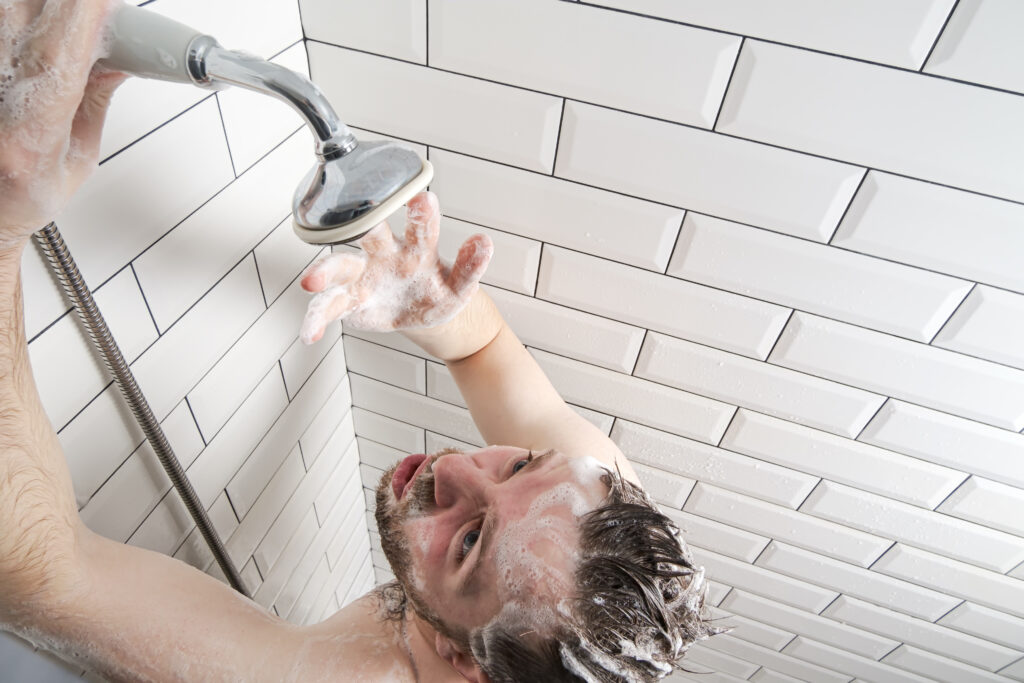A clean shower head can make a big difference in water flow and overall shower experience. To effectively clean a shower head, one can remove it and soak it in vinegar to dissolve mineral deposits and hard water build-up. Keeping the shower head clean is an essential part of regular bathroom cleaning and maintenance.
Many people overlook the shower head during routine cleaning, but neglecting this task can lead to reduced water pressure and uneven spray patterns. Over time, mineral deposits from hard water can accumulate, affecting how well the shower functions. Taking a few minutes to clean the shower head can help maintain its performance and extend its lifespan.
Using simple household items like vinegar and baking soda can make cleaning easy and effective. By incorporating this practice into regular bathroom upkeep, one can enjoy a refreshing shower without the hassle of clogged or inefficient fixtures.
Preparing to Clean Your Shower Head
Before starting to clean a shower head, it is important to gather the right tools and take necessary safety measures. Understanding the type of shower head helps in choosing the best cleaning method.
Safety Precautions and Necessary Tools
Cleaning a shower head can involve some tools and materials that require care. To begin, it’s best to wear gloves to protect hands from any cleaning solution. Safety goggles can also keep eyes safe from splashes.
The following tools may be needed:
- Wrench or pliers: For loosening the shower head if needed.
- Rubber band: Useful for securing the plastic food storage bag around the shower head.
- Zip tie: Can help hold the plastic bag in place if the rubber band isn’t strong enough.
- Tape: To ensure a tight seal around the bag.
Having these items ready will make the cleaning process smoother and safer.
Identifying Types of Shower Heads
Knowing the type of shower head helps determine the proper cleaning method. Common materials for shower heads include metal, brass, and chrome. Each material may require different care.
Types of Shower Heads:
- Fixed shower heads: These are attached to the wall. They may need more effort to clean as they can have hard water buildup.
- Handheld shower heads: These can be removed easily, making cleaning more straightforward.
- Rain shower heads: Usually larger and wider, they require gentle cleaning to avoid damage.
Identifying the type ensures that the right products and methods are used during cleaning.
Step-By-Step Cleaning Methods
Cleaning a shower head can improve water flow and help eliminate bacteria and build-up. Two effective methods include manual cleaning techniques and a soaking method to tackle tougher dirt and mineral deposits.
Manual Cleaning Techniques
For a simple clean, start by removing the shower head. Use a wrench or needle-nose pliers to gently unscrew it.
Next, inspect the shower head for any visible dirt, soap scum, or limescale. A toothbrush can be useful for scrubbing these areas.
Mix a solution of equal parts water and distilled white vinegar in a bowl. Dip a cleaning cloth in the mixture and wipe down the shower head’s surface.
Pay attention to the nozzles, as they can trap dirt and minerals. Use a toothpick or a paper clip to clear any clogged holes.
Reattach the shower head, and run hot water for a few minutes to rinse away any remaining vinegar.
Soaking Method for Deep Cleaning
For deeper cleaning, a vinegar soak is effective. Gather a plastic bag or bowl large enough to submerge the entire shower head.
Fill it with distilled white vinegar or a mixture of water and vinegar. Use rubber bands to secure the bag around the shower head if it’s still attached.
Allow it to soak for at least 30 minutes to an hour. This helps break down stubborn mineral buildup, mold, and gunk.
After soaking, scrub again with a toothbrush to remove any remaining residue.
Rinse well with hot water to ensure all chemicals are washed away. This method restores water pressure and keeps the shower head functioning properly.
Frequently Asked Questions
This section addresses common questions about cleaning shower heads. It covers effective methods, natural cleaning options, and how to tackle tough stains.
What is the most effective method for removing limescale from a shower head?
The best way to remove limescale is to use a mixture of vinegar and water. Soaking the shower head in this solution for a few hours helps break down the limescale buildup effectively.
Can a shower head be cleaned without removing it from the fixture?
Yes, a shower head can be cleaned while still attached. A plastic bag filled with vinegar can be secured around the shower head. This allows the vinegar to soak and clean without removal.
How can I naturally clean and disinfect my shower head?
To clean naturally, lemon juice and vinegar make a good team. Mixing equal parts of both can help disinfect and clean the shower head without harsh chemicals.
What steps are involved in cleaning a shower head using vinegar?
Start by mixing equal parts of vinegar and water. Next, place the mixture in a bag and attach it to the shower head. After soaking for a few hours, scrub with a soft brush and rinse thoroughly.
What can I mix with baking soda to clean a shower head efficiently?
Baking soda can be mixed with vinegar to create a powerful cleaning solution. The fizzing reaction helps to lift grime and buildup from the surfaces of the shower head.
How do I tackle tough stains and buildup on my shower head’s rubber nozzles?
For tough stains, a soft toothbrush and baking soda can be effective. Dampen the brush, dip it in baking soda, and gently scrub the nozzles until clean. Rinse thoroughly to wash away any residue.

